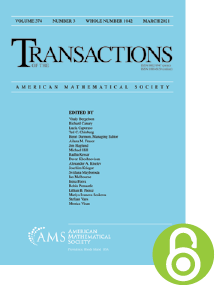Modular and distributive semilattices
HTML articles powered by AMS MathViewer
- by Joe B. Rhodes PDF
- Trans. Amer. Math. Soc. 201 (1975), 31-41 Request permission
Abstract:
A modular semilattice is a semilattice $S$ in which $w \geq$ implies that there exist $x,y \in S$ such that $x \geq a,y \geq b$ and $x \wedge y = x \wedge w$. This is equivalent to modularity in a lattice and in the semilattice of ideals of the semilattice, and the condition implies the Kurosh-Ore replacement property for irreducible elements in a semilattice. The main results provide extensions of the classical characterizations of modular and distributive lattices by their sublattices: A semilattice $S$ is modular if and only if each pair of elements of $S$ has an upper bound in $S$ and there is no retract of $S$ isomorphic to the nonmodular five lattice. A semilattice is distributive if and only if it is modular and has no retract isomorphic to the nondistributive five lattice.References
- Raymond Balbes, A representation theory for prime and implicative semilattices, Trans. Amer. Math. Soc. 136 (1969), 261–267. MR 233741, DOI 10.1090/S0002-9947-1969-0233741-7
- Garrett Birkhoff, Lattice theory, 3rd ed., American Mathematical Society Colloquium Publications, Vol. XXV, American Mathematical Society, Providence, R.I., 1967. MR 0227053
- Peter Crawley, Decomposition theory for nonsemimodular lattices, Trans. Amer. Math. Soc. 99 (1961), 246–254. MR 120173, DOI 10.1090/S0002-9947-1961-0120173-8
- R. P. Dilworth and Peter Crawley, Decomposition theory for lattices without chain conditions, Trans. Amer. Math. Soc. 96 (1960), 1–22. MR 118690, DOI 10.1090/S0002-9947-1960-0118690-9 D. E. Edmondson, Homomorphisms of a modular lattice, Unpublished Doctoral Dissertation, California Institute of Technology, Pasadena, California, 1954. G. Grätzer, Lattice theory, Freeman, San Francisco, Calif., 1971.
- G. Grätzer and E. T. Schmidt, On congruence lattices of lattices, Acta Math. Acad. Sci. Hungar. 13 (1962), 179–185. MR 139551, DOI 10.1007/BF02033636 C. Green, A decomposition property for semilattices, Notices Amer. Math. Soc. 15 (1968), 1040. Abstract #68T-A55.
- Tibor Katriňák, Pseudokomplementäre Halbverbände, Mat. Časopis Sloven. Akad. Vied 18 (1968), 121–143 (German). MR 262123
- Oystein Ore, Chains in partially ordered sets, Bull. Amer. Math. Soc. 49 (1943), 558–566. MR 9017, DOI 10.1090/S0002-9904-1943-07970-0 J. B. Rhodes, Modular semilattices, Notices Amer. Math. Soc. 17 (1970), 272-273. Abstract #672-659.
- Joe B. Rhodes, Decomposition of semilattices with applications to topological lattices, Pacific J. Math. 44 (1973), 299–307. MR 314710, DOI 10.2140/pjm.1973.44.299
- Gábor Szász, Introduction to lattice theory, Third revised and enlarged edition, Academic Press, New York-London; Akadémiai Kiadó, Budapest, 1963. MS revised by R. Wiegandt; translated by B. Balkay and G. Tóth. MR 0166118
- J. C. Varlet, Modularity and distributivity in partially ordered groupoids, Bull. Soc. Roy. Sci. Liège 38 (1969), 639–648 (English, with French summary). MR 277456
Additional Information
- © Copyright 1975 American Mathematical Society
- Journal: Trans. Amer. Math. Soc. 201 (1975), 31-41
- MSC: Primary 06A20
- DOI: https://doi.org/10.1090/S0002-9947-1975-0351935-X
- MathSciNet review: 0351935


